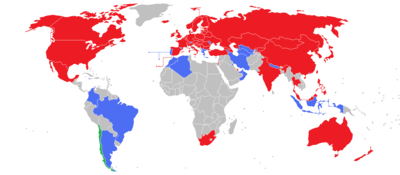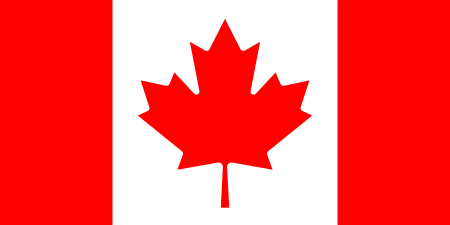Hockey Canada
Hockey Canada, which merged with the Canadian Amateur Hockey Association in 1994, is the national governing body of ice hockey and ice sledge hockey in Canada and is a member of the International Ice Hockey Federation. Hockey Canada controls a majority of ice hockey in Canada.[1][2] There are some notable exceptions, such as the Canadian Hockey League and U Sports (formerly known as Canadian Interuniversity Sport) who are partnered with Hockey Canada, but are not members, as well as any of Canada's professional hockey clubs. Hockey Canada is based in Calgary, with a secondary office in Ottawa, Ontario and regional centres in Toronto, Winnipeg and Montreal.
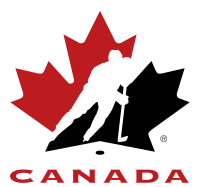 | |
| Founded | 1968 |
|---|---|
| Headquarters | Calgary |
| Location | Ottawa, Toronto, Montreal, Winnipeg |
| President | Scott Smith |
| CEO | Tom Renney |
| Replaced | Canadian Amateur Hockey Association (merger in 1994) |
| (founded) | 1914 |
| Official website | |
| www | |
History
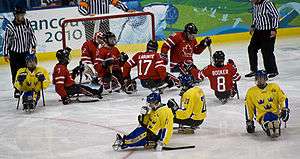
The Canadian Amateur Hockey Association was founded on December 4, 1914, when 21 delegates from across Canada met at the Chateau Laurier in Ottawa. The organization was made to oversee the amateur level of the sport at the national level. The Allan Cup, originally donated in 1908 by Sir H. Montagu Allan, was selected as the championship of amateur hockey in Canada. William Northey, the trustee of the Allan Cup, was named the first ever chairman, while Dr. W. F. Taylor was named the inaugural president. The Memorial Cup was the junior amateur championship of Canada.[3]
In 1920, after the Winnipeg Falcons won the Allan Cup over the University of Toronto, they represented Canada at the 1920 Summer Olympic Games. Canada would go 3-0-0 to win the sport's first ever Olympic gold medal.[3]
The Ottawa and District Amateur Hockey Association joined in 1920, followed by the Maritime Amateur Hockey Association in 1928.[3]
On June 30, 1947, the CAHA, the National Hockey League and the Amateur Hockey Association of the United States makes an agreement that no player under the age of 18 can be signed as a professional player without the permission of their amateur club. That same year, the International Ice Hockey Federation changes the rules on amateur status. The rule change means the 1948 Allan Cup champion Royal Montreal Hockey Club were not eligible for the 1948 Winter Olympics, so the CAHA sent the RCAF Flyers instead and were victorious.[3]
At the 1952 Winter Olympics, the Edmonton Mercuries won their nation's last Olympic gold until 2002.[3]
In 1961, the Trail Smoke Eaters won Canada's 19th and last world championship for 33 years at the 1961 World Ice Hockey Championships. In 1964, Father David Bauer formed the Canada's national team in response to the success of the programs set up by the Soviet Union, Czechoslovakia, and Sweden. Three years later, the CAHA opened its first ever national office, located in Winnipeg.[3]
The Newfoundland Amateur Hockey Association, led by association president Don Johnson, entered the CAHA in 1966. Johnson would become CAHA president in 1975. The New Brunswick Amateur Hockey Association left the Maritime AHA brand in 1968 and entered the CAHA as a member.[3]
In 1968, the Hockey Canada organization was founded to oversee Canada's national teams.
In 1970, the CAHA's 13 Junior A league were divided into two tiers. Tier I, the Western Canada Junior Hockey League, the Ontario Hockey Association, and the Quebec Major Junior Hockey League, were eligible to compete for the Memorial Cup. The ten leagues of Tier II, would compete for the Manitoba Centennial Cup, donated by the Manitoba Amateur Hockey Association (See: Canadian Junior Hockey League).
Also in 1970, Canada pulled out of IIHF competition and would not return to the fold until 1977[3] in protest of the IIHF's soft stance on Soviet and Czechoslovakian teams using "professional amateurs" in international competition but not allowing professional players to compete for Canada.
In 1972, Canada and the Soviet Union competed in the 1972 Summit Series. Canada's team was composed of NHL stars, while the Soviet players were from the Red Army. The NHLers won the series 4-3-1.[3] Two years later, the World Hockey Association represented Canada and lost the series 4-1-3. In 1976, the Canada Cup was formed as a best-on-best championship.
In 1974, the Nova Scotia Amateur Hockey Association and Prince Edward Island Amateur Hockey Association are formed out of the dissolution of the Maritime AHA.[3]
The World Junior Ice Hockey Championships was held for the first time. Canada, who sent Memorial Cup champion teams in early years, eventually set up a national team and won their first gold medal at the 1982 World Junior Ice Hockey Championships.[3]
In 1975, the QMJHL, WCJHL, and the renamed Ontario Major Junior Hockey League form an umbrella organization known as the Canadian Major Junior Hockey League. With the creation of the CMJHL, the three league began initiating compensation talks with the NHL and WHA without CAHA input. In 1980, the CMJHL separated from the CAHA, only staying loosely affiliated with the national body. With the separation of the CMJHL, Tier II was promoted to simply Junior A, although the Tier II title still persists in hockey vernacular. To this day, the CMJHL (now Canadian Hockey League) releases its players to Hockey Canada to play at the World Junior Ice Hockey Championships.
In 1983, the first Abby Hoffman Cup was awarded to the Burlington Ladies as the Canadian national senior champions of women's hockey.
In 1990, the forerunner to the Canadian Junior Hockey League was created as an umbrella organization, within the CAHA, to oversee Junior A hockey.
The Canada women's national ice hockey team was formed in 1987 and won the first (unofficial) world championship that year. The 1990 IIHF Women's World Championship was the first official event, also won by Canada.[3]
In 1994, Team Canada would end a 33-year drought by winning the 1994 Men's World Ice Hockey Championships.[3]
In 1996, Hockey Canada replaces the Manitoba Centennial Cup with the Royal Bank Cup as the championship of Junior A hockey.
In 1998, Hockey Canada and the CAHA merge into one organization. Also, the International Olympic Committee elected to allow professional players to compete at the Olympics and creates a women's event at the games. That same year, Hockey North became the 13th branch of Hockey Canada.[3]
In 2002, the Canadian men and women win gold at the 2002 Winter Olympics in Salt Lake City. The Canadian men win their first gold medal in fifty years, while the women win their first in two tries.[3]
In 2004, the Canada men's national ice sledge hockey team is welcomed into the Hockey Canada fold,[3] and Mark Aubry was named the Chief Medical Officer of Hockey Canada.[4][5]
In 2006, the Canadian women would win gold at the 2006 Olympics and the sledge team conquered gold at the 2006 Winter Paralympics.
The Clarkson Cup, donated by the Governor General of Canada Adrienne Clarkson, was created in 2006, and was first awarded in 2009 to the Canadian national senior champions of women's hockey.[6] The Clarkson Cup replaced the Abby Hoffman Cup.
The IOC and COC informed Hockey Canada that its logo would no longer be allowed on Team Canada jerseys as of the 2010 Winter Olympics.[7] Without the Hockey Canada logo jersey, Team Canada's men and women would win gold in both 2010 and 2014.[8][9]
List of presidents
List of Canadian Amateur Hockey Association presidents (1914–1994), and Hockey Canada presidents (1994–present).[10][11] Prior to the merger of the two organizations in 1994, Hockey Canada leadership included Max Bell, Charles Hay, Doug Fisher, Lou Lefaive, Bill Hay, and Derek Holmes.
- 1914–1915, W. F. Taylor
- 1915–1919, James T. Sutherland
- 1919–1920, Frederick Betts
- 1920–1921, H. J. Sterling
- 1921–1922, W. R. Granger
- 1922–1923, Toby Sexsmith
- 1924–1926, Silver Quilty
- 1926–1928, Frank Sandercock
- 1928–1930, W. A. Fry
- 1930–1932, Jack Hamilton
- 1932–1934, Frank Greenleaf
- 1934–1936, E. A. Gilroy
- 1936–1938, Cecil Duncan
- 1938–1940, W. G. Hardy
- 1940–1942, George Dudley
- 1942–1945, Frank Sargent
- 1945–1947, Hanson Dowell
- 1947–1950, Allan Pickard
- 1950–1952, Doug Grimston
- 1952–1955, W. B. George
- 1955–1957, James Dunn
- 1957–1959, Robert Lebel
- 1959–1960, Gordon Juckes
- 1960–1962, Jack Roxburgh
- 1962–1964, Arthur Potter
- 1964–1966, Lionel Fleury
- 1966–1968, Fred Page
- 1968, Lloyd Pollock
- 1969–1971, Earl Dawson
- 1971–1973, Joe Kryczka
- 1973–1975, Jack Devine
- 1975–1977, Don Johnson
- 1977–1979, Gord Renwick
- 1979–1998, Murray Costello
- 1998–2014, Bob Nicholson
- 2014–2016, Tom Renney
- 2016–present, Scott Smith
Affiliated organizations
- British Columbia Amateur Hockey Association
- Hockey Alberta
- Hockey Eastern Ontario
- Hockey Manitoba
- Hockey New Brunswick
- Hockey Newfoundland and Labrador
- Hockey North
- Hockey Northwestern Ontario
- Hockey Nova Scotia
- Hockey PEI
- Hockey Québec
- Ontario Hockey Federation
- Saskatchewan Hockey Association
Organizations in cooperation with Hockey Canada
On-ice officials
Non-member partners
National competitions
- Allan Cup Senior "AAA"
- Clarkson Cup Women's Senior
- Centennial Cup Junior "A"
- Telus Cup Midget (Minor)
- Esso Cup Female Midget (Minor)
- National Women's Under-18 Championship
- Canada Games - Winter Men's U16 and Women's U18
Inter-Branch
- Fred Page Cup Eastern Region Junior "A"
- Dudley Hewitt Cup Central Region Junior "A"
- Anavet Cup Western Canada Junior "A"
- Doyle Cup Pacific Canada Junior "A"
- Don Johnson Cup Maritime Canada Junior "B"
- Keystone Cup Western Canada Junior "B"
- Maritime-Hockey North Junior C Championships Maritime/Hockey North Junior "C"
- Western Shield Western Canada Female Senior "A" and "B"
Defunct
- Alexander Cup Major Senior
- Hardy Cup Senior "AA"/Intermediate "A"
- Edmonton Journal Trophy Western Canada Intermediate "A"
- Esso Women's Nationals Women's Senior
- Abbott Cup Western Canada Junior "A"
- J. Pius Callaghan Cup Atlantic Canada Junior "A"
- Western Canada Cup Western & Pacific Junior "A"
- Brewers Cup Western Canada Junior "C"
International competitions
 | |
| Association name | Hockey Canada |
|---|---|
| IIHF Code | CAN |
| IIHF membership | 1920 |
| President | Scott Smith |
| IIHF men's ranking | 1 |
| IIHF women's ranking | 2 |
| https://www.hockeycanada.ca | |
Run by Hockey Canada
Run by IIHF
- IIHF World U18 Championships
- IIHF World U20 Championship
- IIHF World Women's U18 Championships
- IIHF World Women's Championships
- Ice Hockey World Championships
- 4 Nations Cup
- Ivan Hlinka Memorial Tournament
- Olympic Winter Games
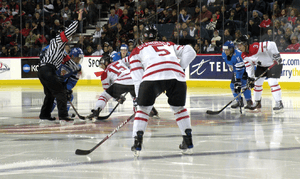
Independent leagues
Some junior leagues, like the Greater Metro Junior A Hockey League and formerly the Manitoba Major Junior Hockey League operate outside the jurisdiction of Hockey Canada. These leagues usually appear for a variety of reasons, ranging from disagreeing with the new Canadian Development Model implemented in 2005 to disagreeing with various zoning restrictions or anger over player raiding by other leagues. In the summer of 2009, Hockey Canada told players that they would have to choose to play within Hockey Canada or outside of Hockey Canada by September 30 of each playing year. At the end of each playing year the player has the right to apply to reenter Hockey Canada if they played in an independent league.
Summer hockey and recreational senior hockey are not under the auspices of Hockey Canada. To date, summer hockey is a massive market and is untouched by Hockey Canada. Also, in summer hockey tournaments, the Hockey Canada rulebook is not always followed, often replaced by professional league rules.
A result of the slow decline of senior hockey in Ontario is the growth of another independent league, the WOAA Senior AA Hockey League. In existence independent since 1943, the WOAA now has 18 senior hockey teams. The WOAA uses the Hockey Canada rule book, but with stricter import rules. The WOAA is very popular in the northern portions of Southwestern Ontario. Most WOAA teams have deep community roots including the sponsorship of minor hockey tournaments.
Less senior hockey has led to widespread growth in recreational adult hockey. Although Hockey Canada has attempted to make moves into recreational hockey and does offer insurance policies to participants, they have failed to make a dent in a nationwide practice.
See also
- Ice Hockey World Championships
- World Junior A Challenge
- World U-17 hockey challenge
- Canadian Hockey Association (1909–1910)
- Canada men's national ice hockey team
- Canada women's national ice hockey team
- Canada men's national ice sledge hockey team
- Canada men's national junior ice hockey team
- Hockey Canada Officiating Program
- Special Hockey International
References
- Nauright, John; Parrish, Charles (1 January 2012). "Sports Around the World: History, Culture, and Practice". ABC-CLIO – via Google Books.
- "Hockey Canada vows to right what went wrong at world juniors | Toronto Star". The Star. January 3, 2016.
- "History of Hockey Canada". Hockey Canada.
- "Paul Loicq Award: Dr Mark Aubry (CAN)". IIHF. 2014. Retrieved 2018-07-31.
- "Dr. Mark Aubry – 2006 Dr. Tom Pashby Sports Safety Award". Dr. Pashby Sports Safety Fund. 2006-11-18. Retrieved 2018-08-01.
- "Need to know: CWHL Clarkson Cup on Sportsnet". Sportsnet. March 10, 2016.
- "Team Canada gets jerseyed by strict Olympic logo rules". The Globe And Mail. November 3, 2008.
- "Canada's core, led by Sidney Crosby, continues world hockey domination". CBC Sports. September 30, 2016.
- "Haley Irwin returns for Four Nations Cup". CBC Thunder Bay. October 18, 2016.
- "Past Officers". Hockey Canada. Retrieved 2018-04-16.
- Constitution, By-laws, Regulations, History. Gloucester, Ontario: Canadian Amateur Hockey Association. May 1990. pp. 125–134.
